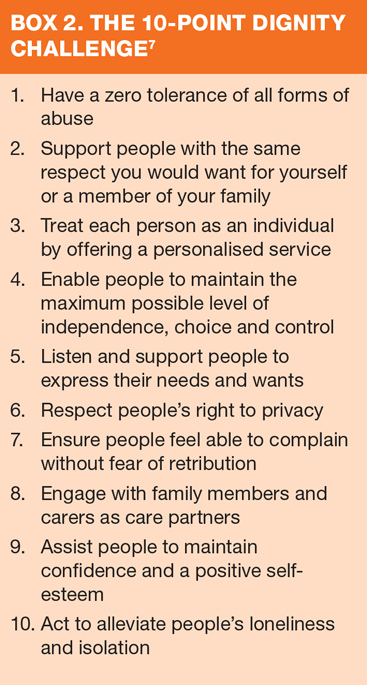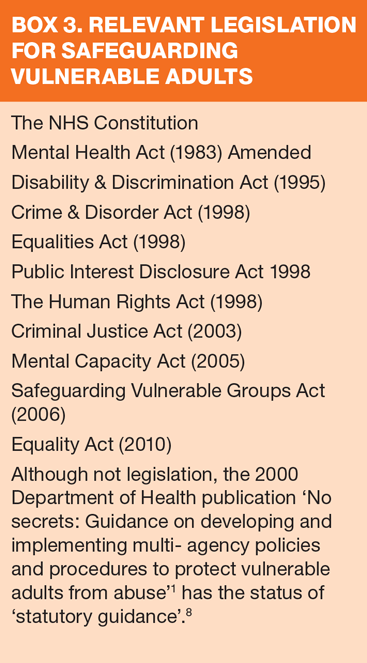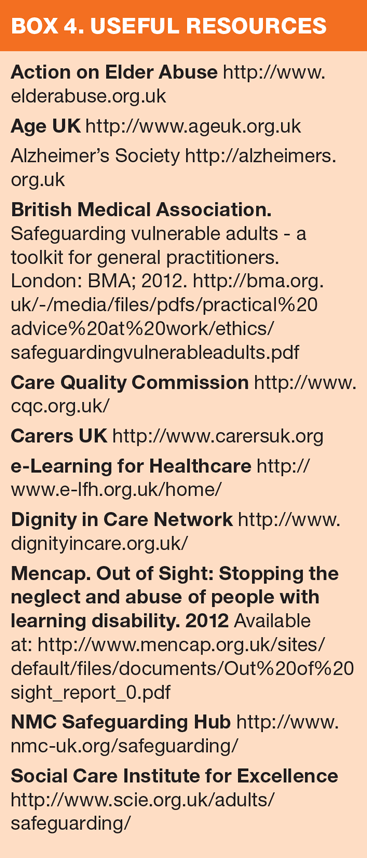Safeguarding vulnerable adults
Katherine Hunt
Katherine Hunt
RGN, RM, BSc (Hons)
Practice Nurse
Framlingham Medical Practice, Suffolk
Safeguarding adults who are vulnerable is integral to our nursing practice in primary care and practice nurses need to be competent and confident in their skills to ensure the safety of patients at risk of harm
Vulnerable adults. You see them in your everyday practice. An elderly lady with dementia walks into your surgery looking unkempt, wearing unseasonal, ill-fitting clothing, covered in old food stains. She says her daughter is too busy to come and see her. Another day, it may be that you notice some unusual bruises on the arm of a patient who is registered blind. Or a young man with a learning disability tells you his friend is looking after his money for him but he never lets him have any for himself. A wife confides in you that her husband is too frightened to go back to the day care centre.
Every human being has a fundamental right to live his or her life free from harm. As health professionals, our responsibility is to promote the health and wellbeing of our patients and to protect those who are less able to protect themselves from abuse, neglect or exploitation at the hands of others. Safeguarding adults who are vulnerable is integral to our nursing practice in primary care and practice nurses need to be competent and confident in their skills to ensure the safety of patients who may be subject to harm or neglect. Not seeing or ignoring abuse and neglect allows it to continue.
THE VULNERABLE ADULT
Who is the vulnerable adult?
The Department of Health’s 2000 ‘No Secrets’ guidance document, seen as a landmark publication for policy on safeguarding the welfare of adults, defines a ‘vulnerable adult’ as someone ‘who is or may be in need of community care services by reason of mental or other disability, age or illness; and who is or may be unable to take care of him or herself, or unable to protect him or herself against significant harm or exploitation’.1 Although there has been some debate over the term and its definition in the intervening years, the ‘No Secrets’ document remains current statutory guidance.2
Adults who are considered to be at an increased risk of abuse and neglect include:3
- An elderly person who is particularly frail due to ill-health, physical disability or cognitive impairment
- An individual with mental health needs, including dementia or a personality disorder
- An adult with a significant and impairing physical or sensory disability
- An adult with a learning disability
- A person with a long term or severe physical illness or condition
- An unpaid carer who may be overburdened, under severe stress or isolated
- A carer who provides personal assistance and care to adults and is subject to abuse
- A homeless person
- Someone who misuses drugs or alcohol
- Any person living with someone who misuses drugs or alcohol
- Women who may be particularly vulnerable as a result of isolating cultural factors
- An adult who is in need of care and support and does not have the ability to make day-to-day decisions
- Someone who self-harms
- Victims of domestic violence
Clearly this list is not exhaustive. An individual’s vulnerability depends on their capability to look after their own needs and interests, whether they are dependent on others for their care and well-being, their ability to communicate either verbally or through assisted technology, as well as their capacity to make decisions and carry out their own informed choices. Lack of self-esteem, self-confidence, social isolation and former life experiences can affect a person’s vulnerability as well as the relationships and support around them.
RECOGNITION OF ABUSE
Abuse can happen to vulnerable adults in a variety of settings – in the person’s own home, in hospital, in day care facilities, in nursing and residential homes or even in public places. Perpetrators of abuse are from all walks of life. They may be a family member, social or health care staff, carers, neighbours, friends, volunteers or members of community groups. They may even be individuals who specifically target vulnerable people in order to exploit them. Abuse may be caused by deliberate intent, negligence or ignorance.1
The ‘No Secrets’ document defines abuse as ‘a violation of an individual’s human and civil rights by any other person or persons’.1 Abuse can be through causing harm, neglecting a person’s needs or failing to provide access to care. It may occur as a single act or on multiple occasions. Abuse takes many forms and there is widely accepted classification of the types of abuse which vulnerable adults suffer – physical, sexual, sexual exploitation, emotional, psychological, financial, neglect, discriminatory and institutional abuse (Box 1).
As practice nurses, we have a responsibility to treat our patients with dignity and respect. It is our duty to deliver care safely, with compassion and integrity and to communicate effectively with our patients.6 The ten principles of the Dignity Challenge should be at the heart of all person-centred health care.7 (Box 2) Moreover, we have a duty to be alert to the potential for abuse with adults at risk and to know how to respond to any alarm bells. Recognition of the signs of abuse, or potential abuse, is the first step to being able to prevent it from continuing or even occurring in the first place.
In general practice, situations that might raise suspicion or concern include:
- Physical signs of abuse such as bruises, burns, abrasions or unexplained injuries
- The presence of pressure ulcers
- Frequent attendance for minor injuries
- Over-use/under-use of medications
- Poor appearance, unkempt, old food stains, lack of hygiene, inappropriate clothing
- Losing weight, malnutrition, not sleeping
- Hunger or thirst
- Not wearing aids to daily living such as appropriate such as hearing-aids, dentures, glasses
- Drowsiness, apathy, withdrawal, depression, anxiety
- Recent change of behaviour
- Recurrent genital and urinary tract infections
- Concerns regarding the relationship and dynamics between the carer and cared-for
- A carer who appears exhausted and overwhelmed by their role
- Avoiding contact with health professionals, not attending appointments
- Disclosure of abuse
Clues to the abuse of vulnerable adults may be subtle. The complexities involved means that, in reality, harm and neglect don’t fit into neatly defined categories or scenarios. Awareness and recognition of alterations in behaviour, physical changes and identification of unequal power in relationships should alert practice nurses to the warning signs of abuse and neglect and in safeguarding the health and wellbeing of our patients. All patients need to be treated as individuals considering their emotional, social, psychological and physical needs in relation to our responses to safeguarding.
OUR ROLE AND RESPONSIBILITY
The Department of Health has developed six safeguarding principles that give guidance to our responsibilities towards vulnerable adults and provide a basis for good practice.8 These principles underpin the safeguarding policies and procedures in primary care and provide a foundation with which to address safeguarding issues:
Principle 1: Empowerment
In line with the NHS vision ‘No decision about me, without me’ any adult suffering abuse or neglect needs to have choice and control over what happens to them in their lives.9 The person suffering abuse must be absolutely central to the decision-making process.
Principle 2: Protection
Patients should be given the support to protect themselves. This may involve multi-agency organisations for adults who are less able to protect themselves.
Principle 3: Prevention
Preventing abuse from occurring or continuing to occur is essential to safeguarding the welfare of vulnerable adults. Our goal is to help individual patients reduce their risks of harm and neglect and to ensure their wellbeing and safety.
Principle 4: Proportionality
The response taken to any abuse suffered by patients should reflect the nature and seriousness of the concern. Such responses need to embrace a person’s age, culture, personal wishes, lifestyle and beliefs. They also need to be least restrictive of a person’s human rights.
Principle 5: Partnership
Communities and agencies need to work in collaboration to prevent, identify and respond appropriately to harm and neglect.
Principle 6: Transparency and accountability
Collaboration and honesty with all agencies involved in the protection of vulnerable adults are essential to ensure safeguarding responsibilities are met and to maintain accountability.
Local policies and procedures, underpinned by the statutory legal framework for safeguarding (Box 3), inform our role and responsibilities with regard to protecting vulnerable adults. Safeguarding training is mandatory. It is our responsibility to ensure that we undertake safeguarding training to update and maintain our skills and knowledge so that in practice we remain alert to the possibility of harm, identifying those at risk and responding to those in need. Safeguarding is our responsibility as individuals but also within the practice as a whole. Sharing with our colleagues through discussion about concerns, addressing safeguarding issues within clinical meetings, knowing how to report a safeguarding concern to the local authority, having systems for identifying and regularly reviewing patients who are vulnerable and maintaining a register of carers within the practice are elements of good practice.
Specifically, the practice nurse’s responsibilities with any safeguarding concerns are to:
- Practise in accordance with the NMC code10
- Be familiar with the local safeguarding policy and procedures
- Be able to identify potential and actual abuse and neglect
- Listen to the patient with care, calmness and demonstrate understanding
- Avoid using leading or probing questions
- Believe a patient if they tell you they have been abused
- Establish the views and wishes of the adult concerned
- Inform the patient that you are required to share information and why
- Gain consent, as appropriate and respect the wishes of the adult concerned
- Know who to report concerns to within the practice
- Never deal with a situation of abuse alone
- Know how to share information with other safeguarding adult agencies and the procedure of referral as per local guidance
- Document all conversations and actions accurately and contemporaneously
- Ensure the safety and wellbeing of the patient
- Ensure protection of the adult if deemed at immediate risk
- Involve the police if a criminal offence has been committed
MENTAL HEALTH CAPACITY ACT (2005)
The person who is suffering abuse or neglect must be involved in any decisions that are taken and must give their consent for any action. Adults who are deemed to have capacity maintain a right to exercise a freedom of choice about their care even if those decisions are not thought to be in their best interests. The statutory principles of the Mental Capacity Act (MCA) 2005 protects people who have a lack of capacity, to ensure that they are included in decisions as far as possible. Any action taken on their behalf is done so by taking into account the individual’s beliefs, values, wishes and feelings, as well as the views of their carers, relatives or advocates, and in relation to the Act’s ‘best interest principles’.11
CONFIDENTIALITY
In nursing practice, confidentiality is fundamental to protecting human rights.12 However, in order to protect patients from harm and to keep them safe, it may be necessary to share information and override that right in specific circumstances. In terms of safeguarding adults, disclosure to appropriate agencies may be necessary if a criminal offence has been committed, if there is danger to life or to the community or when the alleged abuser is a care worker or health care professional.
WHISTLEBLOWING
Concerns about the welfare of vulnerable adults extend to ensuring that the environment in which we work protects our patients. Practice nurses need to be able to challenge any practice by colleagues that could give rise to concerns of abuse. Clearly this raises a number of uncomfortable challenges but when there is legitimate concern about abuse the safety and the welfare of our patients is paramount. The Public Interest Disclosure Act 1998 provides protection for the whistle-blower from recrimination when making a disclosure in the public interest.13 The NMC document, Raising Concerns gives guidance to nurses in relation to whistleblowing.14
CARE QUALITY COMMISSION
Part of the Care Quality Commission (CQC) inspection of general practices is concerned with safeguarding. Individual practices need to demonstrate that patients are ‘protected from abuse, or the risk of abuse, and their human rights are respected and upheld’.15 During inspection, practices may have to provide evidence that staff know how to identify, prevent and respond to abuse. Such evidence may include practice policies, which are regularly reviewed and updated, documentation of safeguarding training for all staff, providing safeguarding information that is easily accessible for patients and carers or demonstrating knowledge of how to respond to a safeguarding concern.
RESOURCES
There is a wealth of safeguarding resources available for health professionals, patients and carers. Guidance and mandatory training for practice nurses can be accessed through Clinical Commissioning Groups, local Safeguarding Adult boards and online resources such as e-Learning for Health or the Social Care Institute for Excellence. The NMC provide an online ‘safeguarding hub’ of resources, fact sheets, training tools, policies and guidance. Organisations such as Age UK, Action on Elder Abuse, and Alzheimer’s Society provide useful fact sheets and leaflets (Box 4).
CONCLUSION
Practice nurses are on the frontline of primary care and therefore must be able to recognise when a patient is at risk of harm and take the vital steps to protect them.
What do you do about that lonely, unkempt elderly lady with dementia whose daughter never visits? Or the man who is registered blind with bruises on his arm. What do you say to the young man who has no control over his money or financial affairs? Can you do something about the gentleman who is scared of going back to the day care centre?
It is our professional and moral duty to safeguard the health and wellbeing of our patients. Prevention and detection of abuse of vulnerable adults in society is crucial. We need to exercise the skills and knowledge we have to make it stop and to support those at risk to make choices for their safety and wellbeing.
REFERENCES
1. Department of Health. No Secrets: Guidance on developing and implementing multi-agency policies and procedures to protect vulnerable adults from abuse. 2000 Available at:
https://www.gov.uk/government/uploads/system/uploads/attachment_data/file/194272/No_secrets__guidance_on_developing_and_implementing_multi-agency_policies_and_procedures_to_protect_vulnerable_adults_from_abuse.pdf
2. Department of Health. Statement of Government Policy on Adult Safeguarding. 2013 Available at: https://www.gov.uk/government/uploads/system/uploads/attachment_data/file/197402/Statement_of_Gov_Policy.pdf
3. British Medical Association. Safeguarding vulnerable adults – a tool kit for general practitioners. London: BMA; 2011.
4. NHS Midlands and East. Safeguarding adults prompt card. 2012 Available at:
http://www.nottingham.ac.uk/healthsciences/documents/safeguarding-adults-prompt-card.pdf
5.Crown Prosecution Service. Honour Based Violence and Forced Marriage [homepage on the internet] No date [cited 17 May 2014] Available at: http://www.cps.gov.uk/legal/h_to_k/honour_based_violence_and_forced_marriage/#a21
6. Nursing and Midwifery Council Discussion Guides: Safeguarding Adults. If you don’t do something who will? 2010 Available at: http://www.nmc-uk.org/Documents/Safeguarding/Toolkit/DISCUSSION%20GUIDE_Film%20one_%20An%20introduction.pdf
7. The dignity care network. The 10 point dignity challenge. 2013 Available at:
http://www.dignityincare.org.uk/Dignity_in_Care_campaign/The_10_Point_Dignity_Challenge/
8. Department of Health. Safeguarding Adults: The role of health service practitioners. 2011 Available at:
https://www.gov.uk/government/uploads/system/uploads/attachment_data/file/215714/dh_125233.pdf
9. Department of Health. NHS Liberating the NHS: No decision about me, without me. 2012 Available at: https://www.gov.uk/government/uploads/system/uploads/attachment_data/file/216980/Liberating-the-NHS-No-decision-about-me-without-me-Government-response.pdf
10. Nursing and Midwifery Council. The code: Standards of conduct, performance and ethics for nurses and midwives. 2008 Available at: http://www.nmc-uk.org/documents/standards/the-code-A4-20100406.pdf
11. SCIE Safeguarding adults at risk of harm: A legal guide for practitioners. 2011 Available at: http://www.scie.org.uk/publications/reports/report50.pdf
12. Nursing and Midwifery Council. Confidentiality. 2013 Available at: http://www.nmc-uk.org/nurses-and-midwives/advice-by-topic/a/advice/confidentiality/
13. House of Commons. Whistleblowing and gagging clauses: the Public Interest Disclosure Act 1998 - Commons Library Standard Note SN00248. 2014 Available at: http://www.parliament.uk/business/publications/research/briefing-papers/SN00248/whistleblowing-and-gagging-clauses-the-public-interest-disclosure-act-1998
14. Nursing and Midwifery Council. Raising Concerns. 2013 Available at: http://www.nmc-uk.org/documents/nmc-publications/nmc-raising-and-escalating-concerns.pdf
15. Care Quality Commission. Guidance about compliance: Essential standards of quality and safety. 2010 Available at:
http://www.cqc.org.uk/sites/default/files/media/documents/guidance_about_compliance_summary.pdf
Related articles
View all Articles



